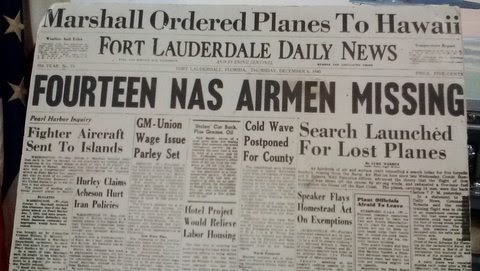 |
| Gen. George C. Marshall U.S. Army |
By Jane Feehan
Among the famous and powerful to visit South Florida during the 1940s was General George C. Marshall (1880-1959), U.S. Army Chief of Staff, who flew in unannounced to the Fort Lauderdale Municipal Airport Nov. 16, 1941.
Marshall “blitzkrieged the entire county” while he paid a visit to Edward Stettinius, Jr. (1900 - 1949), former lend-lease administrator who was vacationing in Pompano Beach. The visit was termed social but turmoil in international affairs provided a more plausible reason for the brief overnight stay. That turmoil resulted in Pearl Harbor, only a few weeks
away.
Pompano remained “blissfully unaware” of the confab until after Marshall’s departure at 7 a.m. the following day aboard a Great Douglas Bomber or C-41 (Eastern Airlines acquired a few C-41s and changed the designation to DC-3). The four-star general and his pilot, Major L.R. Parker, headed to North Carolina to fly over a maneuver area before landing in Washington, D.C.
Stettinius, who later served as secretary of state under President Truman, hosted Winston Churchill in Pompano (actually Hillsboro Beach) in January, 1942. It gave rise to the local myth that Churchill and President Roosevelt met at Cap’s Place for dinner when, in fact, food from the restaurant (and former gambling hub) was delivered to the Stettinius residence for the prime minister’s visit. Roosevelt had suggested Churchill visit Florida (without the president) when he needed a breather from the prime minister who had been in Washington.
It was hoped the vacation would be secret, but the press discovered the trip and Churchill was disapointed. (In Hillsboro, Churchill totally disrobed at the ocean's edge and fell into the water, dousing his cigar, according to a Secret Service agent.)
General Marshall encouraged U.S. assistance in the post-WWII economic recovery of Europe, thus the naming of the Marshall Plan, an unprecedented $17 billion program that helped restore war-ravaged countries. Marshall also served as the nation’s third secretary of defense and as secretary of state under Truman. Copyright © 2015. All rights reserved. Jane Feehan.
For more on Churchill in Florida, see:
https://janeshistorynook.blogspot.com/2020/06/winston-churchill-and-his-miami-beach.html
For a newsreel clip of his arrival in Miami, see: http://tinyurl.com/92x5axf
For more on Churchill at Hillsboro Beach in Broward county during WWII, see:
https://janeshistorynook.blogspot.com/2015/02/wwii-titans-meet-in-pompano-beach-1941.html
https://janeshistorynook.blogspot.com/2020/06/historic-caps-place-gambling-raids.html
Sources:
Fort Lauderdale Daily News, Nov. 17, 1941.
Manchester, William and Reid, Paul. The Last Lion, Vol. 3: Defender of the Realm. 2012.
 |
| Hillsboro Inlet, Pompano Beach Hillsboro Mile, site of Stettinus house north of lighthouse Florida State Archives/Overton |
General Marshall encouraged U.S. assistance in the post-WWII economic recovery of Europe, thus the naming of the Marshall Plan, an unprecedented $17 billion program that helped restore war-ravaged countries. Marshall also served as the nation’s third secretary of defense and as secretary of state under Truman. Copyright © 2015. All rights reserved. Jane Feehan.
For more on Churchill in Florida, see:
https://janeshistorynook.blogspot.com/2020/06/winston-churchill-and-his-miami-beach.html
For a newsreel clip of his arrival in Miami, see: http://tinyurl.com/92x5axf
For more on Churchill at Hillsboro Beach in Broward county during WWII, see:
https://janeshistorynook.blogspot.com/2015/02/wwii-titans-meet-in-pompano-beach-1941.html
https://janeshistorynook.blogspot.com/2020/06/historic-caps-place-gambling-raids.html
Sources:
Fort Lauderdale Daily News, Nov. 17, 1941.
Manchester, William and Reid, Paul. The Last Lion, Vol. 3: Defender of the Realm. 2012.





